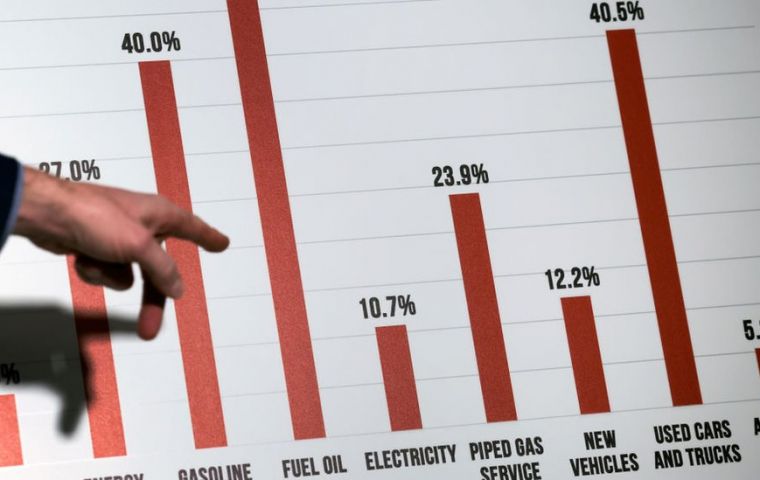MercoPress. South Atlantic News Agency
Despite fears of recession and bank failures, US economy manages 4,9% inflation and unemployment stands at 3,4%
 While prices for milk, airline tickets and new cars fell during April, housing, petrol and used car prices all jumped from March to April
While prices for milk, airline tickets and new cars fell during April, housing, petrol and used car prices all jumped from March to April Inflation in the US has fallen to 4,9%, in the twelve months to April, according to official figures. That was down from 5% in March and marks the tenth month in a row that price rises have slowed.
The fall comes after the US central bank has sharply raised interest rates to try to control inflation. Inflation in the US peaked last June at 9.1% - the highest it has been since 1981.
But officials have hesitated to declare victory, as a problem that once seemed contained to particular sectors - such as energy and manufactured goods - has spread throughout the economy.
While prices for milk, airline tickets and new cars fell during April, housing, petrol and used car prices all jumped from March to April. The cost of haircuts, veterinary visits and gardening services also climbed.
And though no longer soaring, overall prices continue to rise far more quickly than the 2% rate the Federal Reserve considers healthy.
So-called core inflation - which does not include food and energy prices, which change frequently - rose by 5.5% in the 12 months to April.
“With inflation in the US now below 5% for the first time in two years, markets will be thinking the light at the end of the tunnel is getting brighter, and the worst of this inflation is far in the rear-view mirror,” said Richard Carter, head of fixed interest research at Quilter Cheviot.
“That said, inflation remains well above the target level, and core inflation is proving stickier.”
The Federal Reserve has raised interest rates 10 times since last March, bringing them to the highest levels since 2007.
The head of the Federal Reserve, Jerome Powell, signaled this month that officials believe they may have done enough to get inflation under control and could be ready to pause their program of rate rises.
“Slowing food inflation and normalizing energy prices have offered consumers some relief from the most painful parts of the price surge seen over the past couple of years.”
“Even if inflation trends generally seem to be moving in the right direction, we believe it will take significantly more realized progress before policymakers are ready to declare mission accomplished.”
However job creation in the US remained robust last month, despite turmoil in the banking sector and the impact of higher borrowing costs.
Employers added 253,000 jobs, which was better than many analysts had expected. The unemployment rate fell to 3.4%, returning to a multi-decade low.
The gains were a reminder of the resilience of the US labor market, which has held up in the face of aggressive efforts by the US central bank to cool the economy.
The Federal Reserve has raised its benchmark interest rate from near zero to between 5% and 5.25% in little over a year, an abrupt shift aimed at curbing prices that were soaring last year at the fastest pace in decades.
In its Friday report, the Labor Department said hiring had been weaker than previously estimated in February and March. But last month, job creation picked up again, while wages were up 4.4% from a year ago. However recent weeks have seen a flurry of job cut announcements by big companies such as Facebook-owner Meta, Amazon, entertainment giant Disney, banks and other firms.
The rate rises also contributed to turmoil in the banking sector, which has been rocked by the most serious string of failures since the 2008 financial crisis.
But the head of the US central bank, Jerome Powell, said this week that the continuing strength of the labour market made him hopeful that this time would be “different” - and the US could avoid a downturn that would throw millions of people out of work.
“That would be against history,” he acknowledged. “I fully appreciate that.”




Top Comments
Disclaimer & comment rules-

Read all commentsThe problem is that with the suppression of labor rights, the wage bill does not increase, even with more workers in the market.
May 12th, 2023 - 11:58 am 0Inflation has to do with the worldwide devaluation of the dollar, which causes price increases, as the USA abdicated having its own industry to favor neoliberalism (suicide).
Inflation is under control because it has nothing to do with demand or supply. And interest rates rise because the United States is losing liquidity in government bonds. USA is not managing to sell dollars as it used to.
Commenting for this story is now closed.
If you have a Facebook account, become a fan and comment on our Facebook Page!